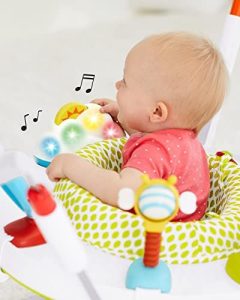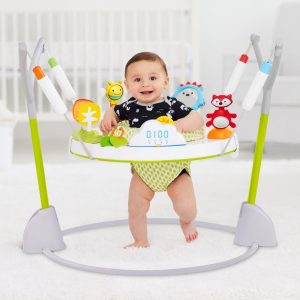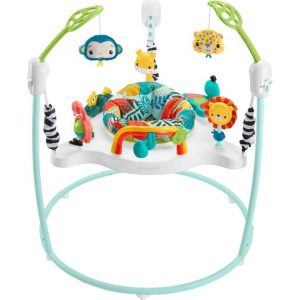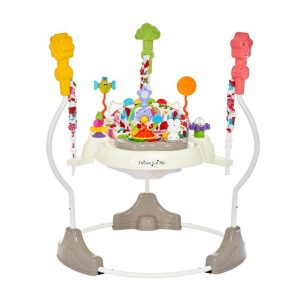Are jumpers good for babies development? Jumpers are a common sight in many households with babies. They provide a fun and stimulating environment for little ones to bounce and play. However, there’s some debate about whether jumpers are truly beneficial for a babies development.
This article explores the pros and cons of jumpers and provides tips for using them safely.
Understanding Developmental Milestones
Before diving into jumpers, it’s important to understand how jumpers help babies development physically. Here’s a brief overview of some key milestones:
Neck and head control:
In the first few months, babies develop head and neck control. They start by lifting their heads while on their tummies and eventually learn to hold their heads steady when upright.
Rolling over:
Around 4-6 months, babies typically develop the ability to roll from their backs to their stomachs and vice versa.
Sitting:
By 6-9 months, most babies can sit with some support. They gradually progress to sitting independently around 9 months.
Crawling:
Crawling usually develops between 6-10 months. This is a crucial milestone that helps babies explore their surroundings.
Potential Benefits of Jumpers
Jumpers can offer some potential benefits for babies, including:
- Strengthens leg muscles: The bouncing motion in a jumper can help strengthen developing leg muscles. This can be helpful for preparing babies for crawling and walking later on.
- Improves coordination: The act of bouncing and pushing off with their legs helps babies develop coordination skills.
- Provides entertainment: Jumpers can be a fun and stimulating way for babies to pass the time. The bouncing motion can be enjoyable for many babies.
Potential Drawbacks of Jumpers
While jumpers can have some benefits, there are also potential drawbacks to consider:
- May delay reaching developmental milestones: Spending too much time in a jumper can limit a baby’s opportunities to practice other important skills like rolling over and crawling. These skills are essential for building overall strength and coordination.
- Strain on developing joints: Jumpers can put strain on a baby’s developing hips and spine, especially if they are used before a baby has sufficient head and neck control.
- Limited social interaction: While bouncing can be fun, it doesn’t provide the same social interaction and learning opportunities that floor play does.
Using Jumpers Safely
If you choose to use a jumper, here are some safety tips to keep in mind:
- Limit jumper time: Aim for short bursts of jumper time, no more than 15-20 minutes at a time.
- Ensure proper fit: The jumper should fit snugly around the baby’s chest and support their armpits. The baby’s toes should be able to touch the floor comfortably.
- Supervise playtime: Never leave a baby unattended in a jumper.
- Age is important: Don’t place a baby in a jumper until they have good head and neck control, typically around 4-6 months old. This ensures their head isn’t flopping around and they can hold it upright independently.
- Start slow: Introduce jumper time gradually. Begin with short sessions (5-10 minutes) and increase the duration as your baby gets used to it.
- Check for discomfort: Pay attention to your baby’s cues. If they seem fussy, frustrated, or sweaty, take them out of the jumper.
Alternatives to Jumpers
There are many other ways to encourage babies development by using jumpers and keep them entertained. Here are some alternatives to jumper:
- Floor play: Floor play is essential for babies to develop their gross motor skills, such as rolling, crawling, and reaching. Provide a safe play area with age-appropriate toys.
- Tummy time: Tummy time strengthens neck and back muscles and helps prepare babies for crawling. Aim for supervised tummy time throughout the day.
- Sitting activities: Once a baby can sit independently, provide them with safe and engaging toys to explore while seated.
Jumpers can be a fun activity for babies in short bursts. However, it’s important to prioritize floor play and other activities that allow babies to develop essential skills at their own pace. By following safety guidelines and choosing a variety of activities, you can create a safe and stimulating babies development to learn and grow.
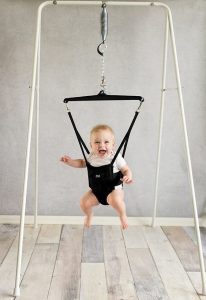
Working with Your Pediatrician
Your pediatrician is a valuable resource for all your baby’s development needs. Here are some ways they can help you regarding jumpers:
- Guidance on safe use: Discuss proper jumper use with your pediatrician. They can advise you on appropriate jumper types, positioning, and time limits for your specific baby.
- Developmental milestones: Talk to your doctor about your baby’s progress in reaching developmental milestones. They can assess if there are any concerns and offer guidance on promoting healthy development through play.
The Importance of Floor Play
Floor play is crucial for a baby’s physical development and overall well-being. Here’s why:
- Strengthens muscles: Floor play allows babies to use various muscle groups as they roll, crawl, reach, and explore their surroundings.
- Improves coordination: Through floor play, babies develop hand-eye coordination, balance, and spatial awareness.
- Encourages exploration: Floor play provides a safe space for babies to explore textures, shapes, and cause-and-effect relationships with toys.
Making Floor Play Fun
Here are some tips to make floor play sessions engaging for your baby:
- Provide a safe space: Create a clean and comfortable area with a soft play mat or carpet.
- Rotate toys regularly: Offer a variety of age-appropriate toys to keep your baby interested. Consider including rattles, crinkly books, and safe teething toys.
- Get down on their level: Interact with your baby during floor play. Sing songs, make eye contact, and talk to them in a playful voice.
Working with a Healthcare Provider
Your child’s healthcare provider is a valuable resource for all your baby’s development needs. Here’s how they can help:
- Guidance on safe jumper use: Discuss proper jumper use with your provider. They can advise you on appropriate types, positioning, and time limits.
- Developmental milestones: Talk to your doctor about your baby’s progress. They can assess if there are any concerns and offer guidance on promoting healthy development through play.
Conclusion
Jumpers can be a fun way to entertain your baby in short bursts. However, prioritizing floor play and other activities that allow for natural development is essential. By following safety guidelines and choosing a variety of activities, you can create a stimulating environment that supports your baby’s growth and learning journey. Remember, your pediatrician is a valuable resource for guidance on safe jumper use and promoting healthy development through play.

